The Moon Ganymede: Laboratory
for Tectonic Motion
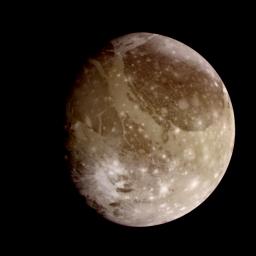 The figure shown to the right is a Galileo Spacecraft image of the third
Galilean moon, Ganymede
(Ref), which has the distinction of being the largest moon in the Solar System.
Its diameter is 5270 km, much larger than our own Moon (3476 kilometers).
This moon is also largely covered by a frozen water
ocean. Portions of its surface look young
geologically and portions look old. It has large grooves in
places, the crust is broken into fragments,
and there is evidence for past plate tectonic activity. This represents the
first conclusive evidence of plate tectonics in the Solar System beyond the
Earth.
The figure shown to the right is a Galileo Spacecraft image of the third
Galilean moon, Ganymede
(Ref), which has the distinction of being the largest moon in the Solar System.
Its diameter is 5270 km, much larger than our own Moon (3476 kilometers).
This moon is also largely covered by a frozen water
ocean. Portions of its surface look young
geologically and portions look old. It has large grooves in
places, the crust is broken into fragments,
and there is evidence for past plate tectonic activity. This represents the
first conclusive evidence of plate tectonics in the Solar System beyond the
Earth.
Young Surface and Old Surface
In the adjacent image the
dark areas are
older, more heavily cratered regions and the light areas are younger,
tectonically deformed regions. The
brownish-gray color is believed
due to mixtures of rocky materials and ice.
Geologically recent
impact craters and their ejecta are indicated by bright regions
(more info).
Detailed Surface Features
The following two images show more detailed features on Ganymede. The left
figure
(Ref)
shows tectonic features (evidence for horizontal crustal motion); the
right figure
shows details of old, darker terrain on Ganymede.
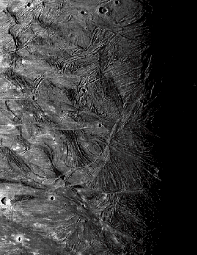 |
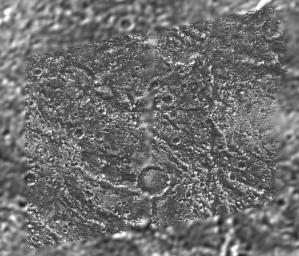 |
|
Tectonic features on the surface of Ganymede
|
The Galileo Regio region on Ganymede
|
The right figure is a mosaic of four Galileo images of
the Galileo Regio region on Ganymede
overlayed on the data obtained by the Voyager 2 spacecraft.
These
Galileo images show fine details of the dark terrain that makes up about half
of the surface.
Ancient impact craters
indicate the great age
of the terrain, dating back several billion years
(more info).
In the left image below,
new terrain overlays older terrain, which overlays still older terrain
on the surface of
Ganymede.
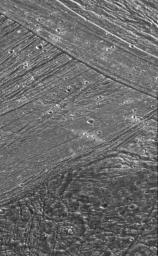 |
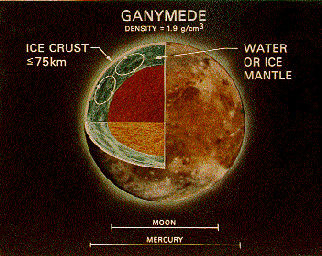 |
|
New and old terrain
|
The structure of Ganymede
|
The images making up this mosaic were obtained by
NASA's Galileo spacecraft
when it flew past Jupiter's moon Ganymede for
the second time on
September 6, 1996
(Ref).
History and Structure of Ganymede
The figure above on the right shows a model of Ganymede
(Ref).
We believe that Ganymede, further from Jupiter and less heated by tidal
effects, is frozen more solid than Europa, but its surface and subsurface is
still somewhat plastic because of tidal heating. The past plate tectonic
activity that we see evidence for may have resulted from the heat generated by
earlier tidal coupling to Jupiter.
 The figure shown to the right is a Galileo Spacecraft image of the third
Galilean moon, Ganymede
(Ref), which has the distinction of being the largest moon in the Solar System.
Its diameter is 5270 km, much larger than our own Moon (3476 kilometers).
This moon is also largely covered by a frozen water
ocean. Portions of its surface look young
geologically and portions look old. It has large grooves in
places, the crust is broken into fragments,
and there is evidence for past plate tectonic activity. This represents the
first conclusive evidence of plate tectonics in the Solar System beyond the
Earth.
The figure shown to the right is a Galileo Spacecraft image of the third
Galilean moon, Ganymede
(Ref), which has the distinction of being the largest moon in the Solar System.
Its diameter is 5270 km, much larger than our own Moon (3476 kilometers).
This moon is also largely covered by a frozen water
ocean. Portions of its surface look young
geologically and portions look old. It has large grooves in
places, the crust is broken into fragments,
and there is evidence for past plate tectonic activity. This represents the
first conclusive evidence of plate tectonics in the Solar System beyond the
Earth.



